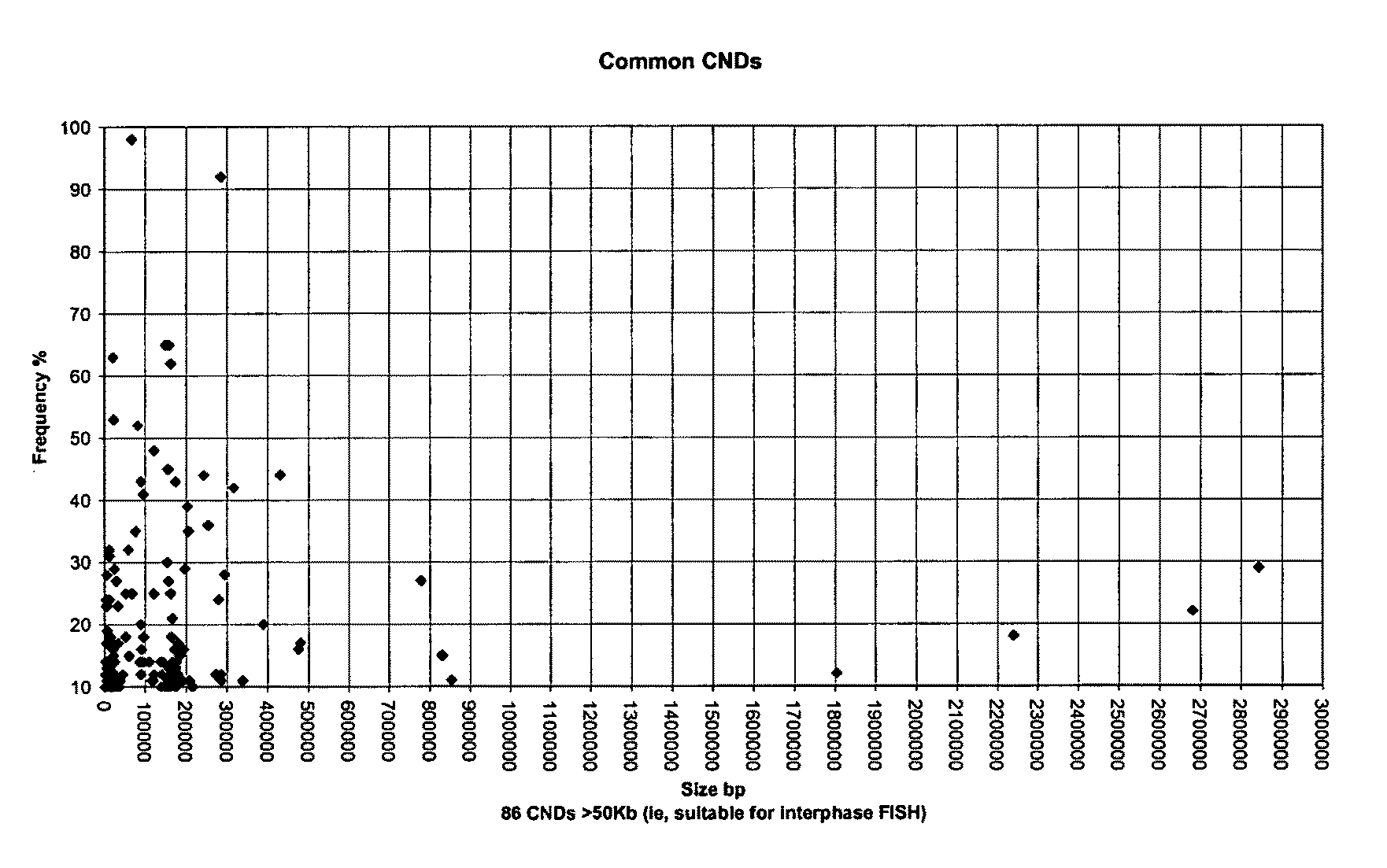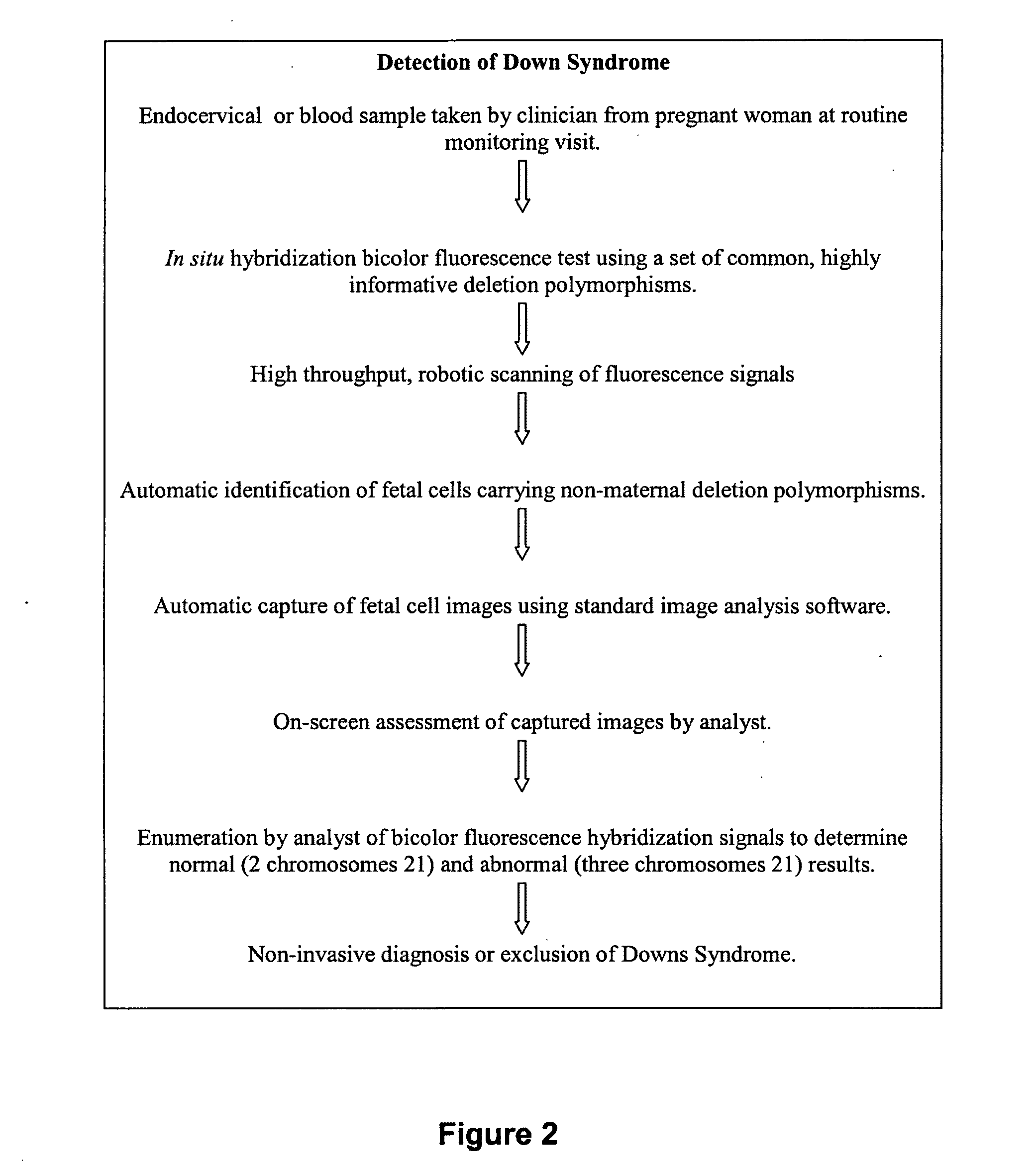Cell detection, monitoring and isolation method
a cell detection and monitoring technology, applied in the field of cell detection, monitoring and isolation methods, can solve the problems of impeded non-invasive tests for determining fetal genetic abnormalities, invasive approaches, etc., and achieve the effect of facilitating the method of treatmen
- Summary
- Abstract
- Description
- Claims
- Application Information
AI Technical Summary
Benefits of technology
Problems solved by technology
Method used
Image
Examples
example 1
Detection of Donor Cells in Bone Marrow Transplant Patients
[0099]A copy number deletion present in the transplant patient or recipient's DNA which is not present in the donor's DNA is detected to distinguish the donor cells in the recipient.
[0100]By using two color FISH test using a probe within and an adjacent probe outside the copy number deletion, the recipient non-deleted locus is one color such as yellow (red+green) and the copy number deletion is red. If the copy number deletion is not present, the donor cells show a signal which is two yellow signals (red+green).
[0101]The test is also done with only one color (e.g. red) using a probe within the recipient copy number deletion. Recipient cells show one red signal and the donor cells show two red signals. As false positive cells showing two signals are unlikely, i.e. Recipient cells masquerading as donor cells, this single color test is applicable here.
[0102]This test is not restricted to using host / recipient specific copy numbe...
example 2
Detection of Down Syndrome
[0105]A schematic protocol for detecting Down Syndrome is shown in FIG. 2.
[0106]Individuals with Down Syndrome have trisomy 21, i.e. have three instead of two chromosomes 21. The assay is a non-invasive pre-natal test for trisomy 21, which is performed in situ on the microscope slide, thus avoiding the need to manually isolate fetal cells. The test is based on the analysis of a class of DNA polymorphism called Copy Number Variation (CNV). Fetal cells are distinguished from maternal cells through detection of non-maternal copy number variations. Specifically, deletion polymorphisms are used that have been inherited by the fetus from the father and are not carried by the mother. As only fetal cells carry these non-maternal polymorphisms, they can be distinguished from maternal cells. Deletion polymorphisms are located throughout the human genome. By using deletion polymorphisms located on chromosome 21 with the in situ assay, not only are fetal cells identifi...
example 3
Detection of Cells from a Fetus with Down Syndrome Method 1
[0110]An endocervical sample is taken by a clinician from a pregnant woman at routine monitoring visit at approximately seven weeks gestation. Such a sample contains mainly maternal endothelial cells with small numbers of cells of fetal origin. An aliquot of the cell preparation is pipetted onto a standard glass microscopy slide and air dried at ambient temperature.
[0111]The Fluorescence in situ hybridization (FISH) test discriminates maternally and paternally derived DNA loci within the cells. Only fetal cells contain paternally derived loci and this is the basis on which fetal cells are distinguished from maternal cells. Any paternally derived locus is suitable for identification of fetal cells but those on chromosome 21 are most suitable for simultaneous assay of the number of chromosome 21s present for diagnosis of Down syndrome (see FIG. 3).
[0112]A locus is selected either by:
(1) prior knowledge of its presence through ...
PUM
| Property | Measurement | Unit |
|---|---|---|
| temperatures | aaaaa | aaaaa |
| temperatures | aaaaa | aaaaa |
| temperatures | aaaaa | aaaaa |
Abstract
Description
Claims
Application Information
 Login to View More
Login to View More - R&D
- Intellectual Property
- Life Sciences
- Materials
- Tech Scout
- Unparalleled Data Quality
- Higher Quality Content
- 60% Fewer Hallucinations
Browse by: Latest US Patents, China's latest patents, Technical Efficacy Thesaurus, Application Domain, Technology Topic, Popular Technical Reports.
© 2025 PatSnap. All rights reserved.Legal|Privacy policy|Modern Slavery Act Transparency Statement|Sitemap|About US| Contact US: help@patsnap.com



